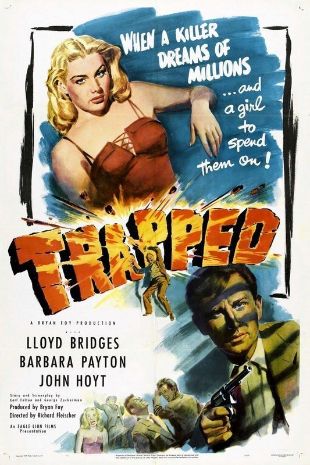
Trapped was one of the earlier films to follow in the wake of He Walked by Night -- made at the same studio, Eagle Lion -- which utilized a documentary-style approach to present a crime story (He Walked By Night, in turn, was merely adopting a technique that had been popularized at 20th Century Fox in such fact-based espionage stories as The House on 92nd Street). The technique was still fresh enough that it could hold audience interest at the time, though its handling here is somewhat clunky -- the documentary portion at the opening is fine, but the slice-of-life scene intended to support it is played and shot so uninterestingly, that it almost stops the movie and the action (which hasn't even started yet) dead in their tracks at three minutes into the picture. All of which is a pity, because from the five-minute mark onward, this is a solid, fast-moving crime thriller, with some unexpectedly complex elements, that picks up steam and tension as it rolls forward. The script is filled with double- and triple-crosses that seem obvious until they start forming up in layers, so that by the midway point there are enough overlapping scams being run by almost everyone involved to make Trapped seem as twist-laden as any two Mission: Impossible scripts. Director Richard Fleischer brings a smooth, low-key style to the plot and an up-close-and-personal approach to the violence, which makes for an intense viewing experience. Lloyd Bridges' weasel-like performance here as the man at the center of a government investigation and a double-cross (but by whom?) is practically a rehearsal for his work as the psychopathic criminal in Cyril Endfield's Try and Get Me a year later; he portrays a lean and hungry look that seems to go down into his soul and makes his pathological performance totally convincing, though his work here is also stiff at times, hemmed in as he is by some routine gangster movie jargon and posturing. The real surprise for many viewers, however, will be the presence of John Hoyt, playing a kind of "deep cover" treasury agent -- those accustomed to Hoyt's one-note character performances over the years, mostly as taciturn misers or eccentric older relatives, may be amazed to see the chameleon-like work that he does in the role of a man forced to wear several guises in his work and to switch them from moment to moment, from oily man-on-the-make to two-bit grifter to dedicated lawman; indeed, Hoyt's character is as much the focus of the movie as Bridges', and their duality, representing two very different kinds of men driven by deep passions, is the real focus of the movie. Each character finds himself trapped on impossibly dangerous ends of the same double- (or triple-) cross, by virtue of the kind of person that he is -- when they finally reveal who they are to each other, the confrontation stops just slightly short of murder. The movie also offers viewers an ancillary visual/historical treat in its final minutes -- amid the location shooting done in Los Angeles, the writers and producers staged a chase in the storage yard for the city's trolley system, which was to disappear soon after (to the regret of subsequent generations of residents, trapped in hopeless traffic jams); indeed, the yard and the noises of the trolleys are essential in structuring the movie's finale, which is only a little less engrossing than the chase on the Williamsburg Bridge that ends Naked City, another crime film within the same sub-genre.
